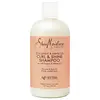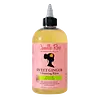What's inside
What's inside
 Key Ingredients
Key Ingredients

 Benefits
Benefits

 Concerns
Concerns

 Ingredients Side-by-side
Ingredients Side-by-side

Water
Skin ConditioningDecyl Glucoside
CleansingSodium Lauroyl Lactylate
EmulsifyingGlycol Stearate
EmollientParfum
MaskingButyrospermum Parkii Butter
Skin ConditioningPanthenol
Skin ConditioningGuar Hydroxypropyltrimonium Chloride
Skin ConditioningSodium Lauroyl Hydrolyzed Silk
Skin ConditioningCitric Acid
BufferingStearamide Amp
Melia Azadirachta Seed Oil
EmollientBrassica Campestris Seed Oil
Skin ConditioningSodium Phytate
Cocos Nucifera Oil
MaskingRosmarinus Officinalis Leaf Oil
MaskingTocopherol
AntioxidantHibiscus Rosa-Sinensis Flower Extract
HumectantAloe Barbadensis Leaf Juice
Skin ConditioningGlycerin
HumectantGlycine Soja Oil
EmollientSodium Benzoate
MaskingCaprylyl Glycol
EmollientTriethyl Citrate
MaskingBenzoic Acid
MaskingWater, Decyl Glucoside, Sodium Lauroyl Lactylate, Glycol Stearate, Parfum, Butyrospermum Parkii Butter, Panthenol, Guar Hydroxypropyltrimonium Chloride, Sodium Lauroyl Hydrolyzed Silk, Citric Acid, Stearamide Amp, Melia Azadirachta Seed Oil, Brassica Campestris Seed Oil, Sodium Phytate, Cocos Nucifera Oil, Rosmarinus Officinalis Leaf Oil, Tocopherol, Hibiscus Rosa-Sinensis Flower Extract, Aloe Barbadensis Leaf Juice, Glycerin, Glycine Soja Oil, Sodium Benzoate, Caprylyl Glycol, Triethyl Citrate, Benzoic Acid
Zingiber Officinale Root Oil
MaskingDisodium Cocoamphodipropionate
CleansingSodium C14-16 Olefin Sulfonate
CleansingCocamidopropyl Betaine
CleansingCitric Acid
BufferingPimpinella Anisum Seed Oil
MaskingRicinus Communis Seed Oil
MaskingPhenoxyethanol
PreservativeEthylhexylglycerin
Skin ConditioningPolyquaternium-10
Sodium Cocoyl Isethionate
CleansingDecyl Glucoside
CleansingGlycol Distearate
EmollientGuar Hydroxypropyltrimonium Chloride
Skin ConditioningZingiber Officinale Root Oil, Disodium Cocoamphodipropionate, Sodium C14-16 Olefin Sulfonate, Cocamidopropyl Betaine, Citric Acid, Pimpinella Anisum Seed Oil, Ricinus Communis Seed Oil, Phenoxyethanol, Ethylhexylglycerin, Polyquaternium-10, Sodium Cocoyl Isethionate, Decyl Glucoside, Glycol Distearate, Guar Hydroxypropyltrimonium Chloride
Ingredients Explained
These ingredients are found in both products.
Ingredients higher up in an ingredient list are typically present in a larger amount.
Citric Acid is an alpha hydroxy acid (AHA) naturally found in citrus fruits like oranges, lemons, and limes.
Like other AHAs, citric acid can exfoliate skin by breaking down the bonds that hold dead skin cells together. This helps reveal smoother and brighter skin underneath.
However, this exfoliating effect only happens at high concentrations (20%) which can be hard to find in cosmetic products.
Due to this, citric acid is usually included in small amounts as a pH adjuster. This helps keep products slightly more acidic and compatible with skin's natural pH.
In skincare formulas, citric acid can:
While it can provide some skin benefits, research shows lactic acid and glycolic acid are generally more effective and less irritating exfoliants.
Most citric acid used in skincare today is made by fermenting sugars (usually from molasses). This synthetic version is identical to the natural citrus form but easier to stabilize and use in formulations.
Read more about some other popular AHA's here:
Learn more about Citric AcidDecyl Glucoside is a glucose-based surfactant and emulsion stabilizer. It is created by reacting glucose with the fatty acids from plants.
Surfactants help clean the skin by trapping oil, sebum, and dirt to be washed away. As an emulsion stabilizer, it stabilizes the ingredients in a product by preventing them from separating.
This ingredient is biodegradable and non-toxic. This ingredient is commonly found in baby shampoos.
Decyl Glucoside is sometimes used to stabilize the UV filter Tinosorb.
Learn more about Decyl GlucosideThis ingredient is derived from guar gum.
It is a conditioning ingredient, meaning it helps soften skin and hair.